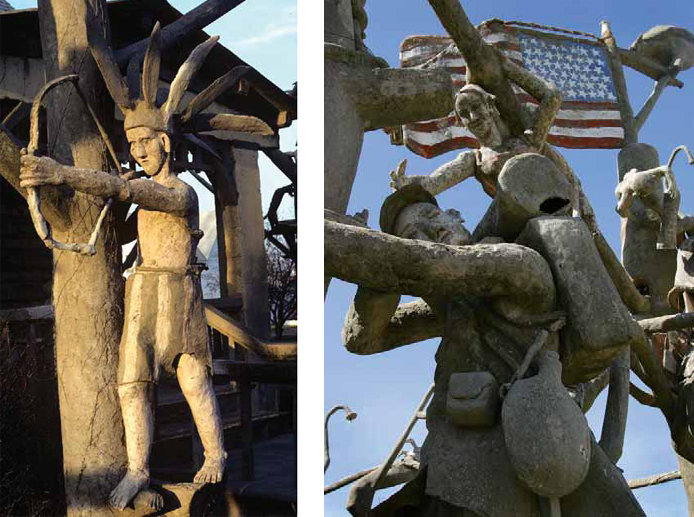By Erika Nelson
Across the Midwest, rural communities are losing their population to out-migration as family farms close under pressure from an increasingly corporate agricultural industry and decreasing populations translate into loss of business opportunities in small towns. Small Midwestern communities are dying.
Across the Midwest, rural communities are losing their population to out-migration as family farms close under pressure from an increasingly corporate agricultural industry and decreasing populations translate into loss of business opportunities in small towns. Small Midwestern communities are dying.
The Garden of Eden in Lucas, Kansas, was one man’s artistic vision rendered in concrete, but others carry on the tradition a century later.
But Lucas, Kansas, a small farming community of 430 people nestled in the Geographic Center of the United States, is not dying. I believe this is due, in part, to S.P. Dinsmoor’s folk art environment, the Garden of Eden. Built from 1907 to 1932, S. P. Dinsmoor captured the social climate of the era through his sprawling concrete illustration of politics at the turn of the century, from the perspective of the Populist Party.
Since the town of Lucas has in its development this internationally known icon of the Visionary/Outsider Art world, the structure of the town itself is informed by, influenced by, and an integral part of the Garden of Eden. Dinsmoor moved to Lucas one year after its founding in 1887, and, along with his Civil War buddies, started the first debate society in the area. Through these open forums, the common man had the opportunity to explore multiple points of view. Dinsmoor and his friends also formed a chapter of the Populist Party, an outgrowth of the Farmers Alliance, established to aid the array of immigrants lured to the region by promises of free homesteads in an environment that proved to be unforgiving and harsh.
The area was settled under the notion that the West was a paradise of fertile ground. The railroads perpetuated this myth by naming regional Kansas towns Paradise, Enterprise, Haven, Admire, and Hope. Capitalizing on this, Dinsmoor set out to create a physical Garden of Eden. His Old Testament-inspired narratives are put forth with humor and a good bit of artistic license. While there is a nod to the creation story, the Garden is primarily a comment on social structure and politics at the early part of the 20th century rather than an overtly evangelical environment.

A woman chasing a soldier starts the Social Darwinism section; the soldier is aiming at an Indian, who is aiming at a dog. Photos by Jon Blumb.
Dinsmoor started the Garden with a simple fence, then added his ‘Cabin Home,’ built from native Post Rock limestone, so called because of its use as fence posts due to lack of timber in the Kansas prairie. In the Oct. 14, 1909 issue of the Lucas Independent, Dinsmoor described his home as the “Best built house in the state. The most unique outside and prettiest finished inside of any dwelling on earth.” Surrounding his Cabin Home is a forest of concrete trees supporting figural sculptures illustrating the story of the Garden of Eden and Populist Party politics.
Cain and Abel; Goddess of Liberty; Adam and Eve; the Devil. Photos by Jon Blumb.
Erika Nelson is an independent artist and educator in Lucas, Kansas. When not promoting and volunteering in her adopted home town, she explores the back roads of the U.S. looking for World’s Largest Things. She uses eye-catching vehicles for her pilgrimages: her converted mini- bus/traveling museum which houses the World’s Largest Collection of the World’s Smallest Versions of the World’s Largest Things and her art car, “Scout.” She documents her findings at World’sLargestThings.com.
There’s more! To read the rest of this article, members are invited to log in. Not a member? We invite you to join. This article originally appeared in theSCA Journal, Spring 2009, Vol. 27, No. 1. The SCA Journal is a semi-annual publication and a member benefit of the Society for Commercial Archeology.
More Articles Join the SCA


